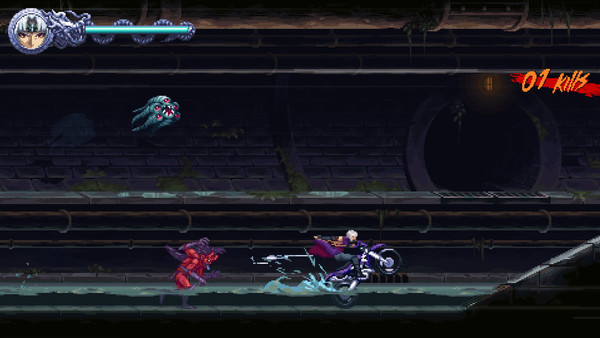Game Review
by George Yang,Ninja Gaiden: Ragebound Game Review
Xbox Series X/S
| Description: |  |
||
Ninja Gaiden: Ragebound is a 2D action platformer developed by The Game Kitchen, the studio behind Blasphemous. It follows two characters, Kenji Mozu of the Hayabusa Village and Kumori of the Black Spider Clan. Despite being enemies and both on the brink of death, Kenji is forced to fuse his body with Kumori's soul in order to stay alive. With their abilities in tow, they set out to stop a demonic threat from taking over Japan. |
|||
| Review: | |||
Ninja Gaiden: Ragebound feels like a game straight out from the 1980s and 90s, especially with its story and higher difficulty threshold. The game's plot is rather one-note, with Kenji vowing to take revenge on the demons and Kumori attempting to double-cross the Demon Lord. Eventually, both Kenji and Kumori develop a sense of camaraderie towards the end of the game, having been fighting alongside each other. Regardless of how simple the story is, these motivations are enough to lay a foundation that highlights the game's strengths, which are its gameplay and combat.  © KOEI TECMO GAMES CO., LTD. All rights reserved. Developed by The Game Kitchen, published by Dotemu SAS Even though Ragebound is a 2D game, the developer managed to find ways to make it more cinematic. For example, there's a level where you fight while hanging on a helicopter and another where you fight enemies through a speeding train. This allows the game's 8-bit and 16-bit-inspired art style to shine. The controls and animations are surprisingly fluid and responsive, making it feel more like a modern game than a stilted one from the NES era. At the end of each level, you're graded on a rank up to S+, depending on how well you did. There are also unique challenges to beat on each level, such as defeating the boss within a certain time frame or completing the level without dying. These added challenges and achieving higher ranks give Ragebound much-needed replayability, as the main story itself is rather short at around 10-12 hours. One gripe I have with the way some challenges are structured is that if you fail one, you have to restart the stage. For example, there's one where you have to avoid being hit during the bullet train sequence, but that part is later in the level. To restart that challenge, you'll have to restart the whole level to get to that sequence. It's a frustrating and annoying process, making these challenges artificially more difficult to complete.  © KOEI TECMO GAMES CO., LTD. All rights reserved. Developed by The Game Kitchen, published by Dotemu SAS Speaking of difficulty and replayability, Hard Mode is unlocked after finishing the game once. This creates a new playthrough by changing some of the enemies, such as those in the beginning, to shoot three ninja stars at you instead of one. Boss battles are also much harder. For example, the first stage boss, the demonic dragon-like creature Gurthka, now has a permanent fire pit in the middle of the arena, along with more aggressive behaviors. It's another great way to challenge players and extend the game's longevity. Ninja Gaiden: Ragebound is an exemplary 2D side-scrolling action game that takes the best part of old school 80s and 90s mechanics and mixes them with modern sensibilities. Composer Sergio de Prado did a fantastic job creating the soundtrack filled with electrifying guitars that match the game's fast-paced action. Alongside solid core combat and replayability options, Ninja Gaiden: Ragebound is bound to please both retro and contemporary fans. |
| Grade: | |||
|
Overall : A
Graphics : A
Sound/Music : A+
Gameplay : A
Presentation : A
+ Retro gameplay feels fluid and responsive, with plenty of replayability despite its short run time, along with stylish art direction and impressive soundtracks. |
|||
| discuss this in the forum | | |||